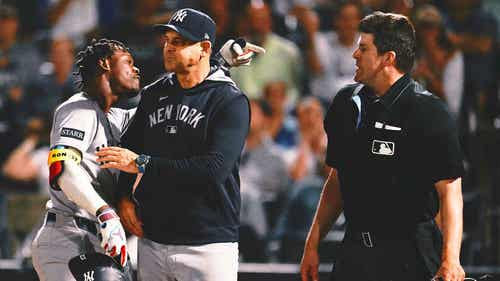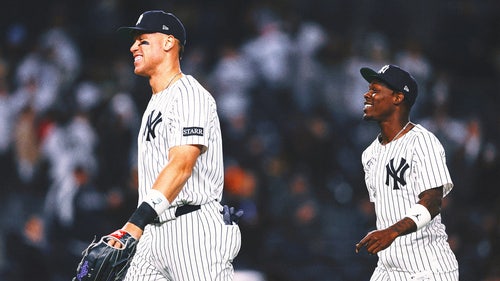
Worrying (or not!) about some pitchers with ugly ERAs
There are a lot of hitters with truly putrid numbers right now, and Monday I wrote about some of them. As promised, I’m back with a look at some scary pitchers, and let’s start with the Sextet of Sixes: the six ERA title qualifiers (through Sunday’s games) with ERAs that begin with 6 (or 7!) ...
Minnesota’s Kevin Correia (0-3, 7.33) has been living on the edge for a while, as his strikeout rate plummeted in 2011. He made it work, though, by dropping his walk rate as well. But this season his strikeout rate is down even more whilst his walk rate is up, and that’s an unworkable combination. Things might actually be worse for Correia, as he’s given up only two home runs in his five starts. On the other hand, he’s given up an unlucky .343 batting average on balls in play (BABiP). On the other hand, he seems to have lost another mile off his fastball. Correia’s ERA will probably drop, if only because it has to. But enjoy the Twins’ wildly successful pitch to contact philosophy while you can, because Correia’s going to be one of its last exemplars -- and perhaps its most spectacular.
Oh, but Kevin Correia might not be the last exemplar, as Ricky Nolasco (2-2, 6.67) just signed a four-year, $49 million contract that runs through 2017. This is probably just an example of Ordinary Baseball Weirdness (OBW), though, as Nolasco’s strikeout rate is down by nearly 50 percent even though he’s throwing the same stuff he’s always thrown.
Seattle’s Erasmo Ramirez (1-3, 6.75) has fared nearly as poorly as Correia, but at least he’s out of the rotation; last week the M’s demoted Ramirez to the minors.
Remember when Baltimore’s Ubaldo Jimenez (0-4, 6.59) was one of the hottest pitchers on the free-agent market. Yeah, that was awesome. Now he’s a hot mess, with the highest walk rate in the American League. Is all of this really so shocking? After all, just two seasons ago, Jimenez finished 9-17 with a 5.40 ERA. Then again, last season he seemed to find himself, with a 3.30 ERA and a strikeout-to-walk ratio right in line with his good seasons in Colorado. Was it a mirage, though? In Baseball Prospectus 2014, Susan Petrone wrote that Jimenez’s adjustments last season, “such as increasing the percentage of sliders he throws, seems more like a walk-year ambush on unprepared hitters, and less like the subtle refinements of a repeatably effective repertoire.” He’s actually throwing nearly as many sliders this season, but he’s throwing those sliders, and his fastballs too, a couple of miles an hour slower than last season. Maybe it’s just a temporary issue, one of those dead arms that seem to come and go so mysteriously. If it’s not, the Orioles will have learned a $50 million lesson that too many teams have learned before.
Finally some good news! Yes, Cincinnati’s Homer Bailey (1-2, 6.15) has that bloated ERA. And yes, the Reds just invested $105 million in their young ace. But his arm seems fine, his strikeout rate is higher than ever, and his walk rate is stable. He’s simply been wildly unlucky (OBW Alert!) on batted balls, giving up seven homers in five starts and a ridiculous .416 BABiP. Bailey’s luck will improve, and his ERA will plummet.
More bad news! Cleveland’s Danny Salazar (0-3, 6.04), so impressive down the stretch last season, has been dreadful this season. Actually, there’s some good news here, too: Salazar’s strikeout rate remains high -- the fourth-highest in the American League -- and his walk rate’s nothing to worry about. But he’s given up a .388 BABiP, which just isn’t going to continue. Salazar might not be the new Homer Bailey, but he remains one of the game’s more interesting young pitchers despite those ugly numbers at the top.
Next, five more pitchers who piqued my curiosity ...
It’s hard to know just what to make of Tim Lincecum (1-1, 5.96). When you look at his ERA, you assume his struggles last season have carried over to this season, and he is throwing exactly the same pitches. But his strikeout rate remains high and his walk rate is the lowest of his career ... which would be really keen, except that one-fourth of the fly balls he’s given up have carried the fence for home runs. If you believe in xFIP, Lincecum’s pitching like a Cy Young candidate; if you don’t, he’s having the worst season of his career. Like I said, I don’t know what to think. But considering the excessive home-run rate is essentially an extra three big flies in five games, we might at least hope that Lincecum has actually learned to pitch effectively with a sub-par fastball.
I’m sorry to report that Brandon McCarthy (0-5, 5.54) is the only five-game loser in the majors. But may I say, with all due objectivity, that it’s hardly his fault? McCarthy’s actually throwing significantly harder than ever -- maybe because of all those new muscles? -- which has resulted in the highest strikeout rate of his career. He’s also completely junked his ineffective change-up. But like Lincecum, McCarthy’s given up too many home runs: seven, among only 26 fly balls. Whatever McCarthy’s doing, it’s fundamentally worked; fortunately, he’s smart enough to understand this, and stick with it.
It’s much the same story for Oakland’s Dan Straily (1-1, 5.14), whose strikeout and walk rates are perfectly fine. And he’s actually been hit-lucky, with just a .264 BABiP allowed. But like McCarthy, Straily’s ERA is bloated by giving up seven homers already. Unlike McCarthy, Straily’s actually throwing a bit softer this season ... and of course he was throwing pretty soft before. Which doesn’t mean he can’t pitch effectively in the high 80s; his strikeout-to-walk ratio suggests he can. It’s something to watch, though. Especially since Straily isn’t a ground-ball pitcher. He does need to miss bats, or he will get hurt by the homers.
And then there’s Shelby Miller, who’s 2-2 with a lovely 2.86 ERA ... and has been one of the worst pitchers in the National League. Consider: Miller’s given up five homers in five starts, along with 18 walks in 28 innings. So how does he manage a 2.86 ERA? Well, the 25 strikeouts help. So do clutch pitching and a little help from his bullpen friends. Might all those walks be anomalous, though? His arm seems fine, and there are all those strikeouts. This is the thing we must keep in mind: It’s still only April, and in Miller’s case we’re talking about just 28 innings. Remove just six walks, and we’re not even having this discussion. So I won’t believe Shelby Miller’s broken until it’s official. And so far it’s highly unofficial.
Finally, we’ve got the immortal Bartolo Colon. You know him for his hitting feats, and his 4.50 ERA must be disappointing to the Mets (or at least their fans). But let us wonder at the marvel: Colon turns 41 next month and will earn $9 million this season, but somehow he ranks fourth in the majors in strikeout-to-walk ratio, behind only superstars Tim Hudson, Cliff Lee, and David Price. I don’t know what’s going to happen to his ERA, I don’t know how long he’ll avoid the Disabled List, and I don’t know if he’s discovered the Fountain of Youth. I do know I’m going to record his next start, and download it to my little piece of the Singularity.
Rob Neyer’s Twitter feed is jam-packed with baseball and other nerdy pursuits.








